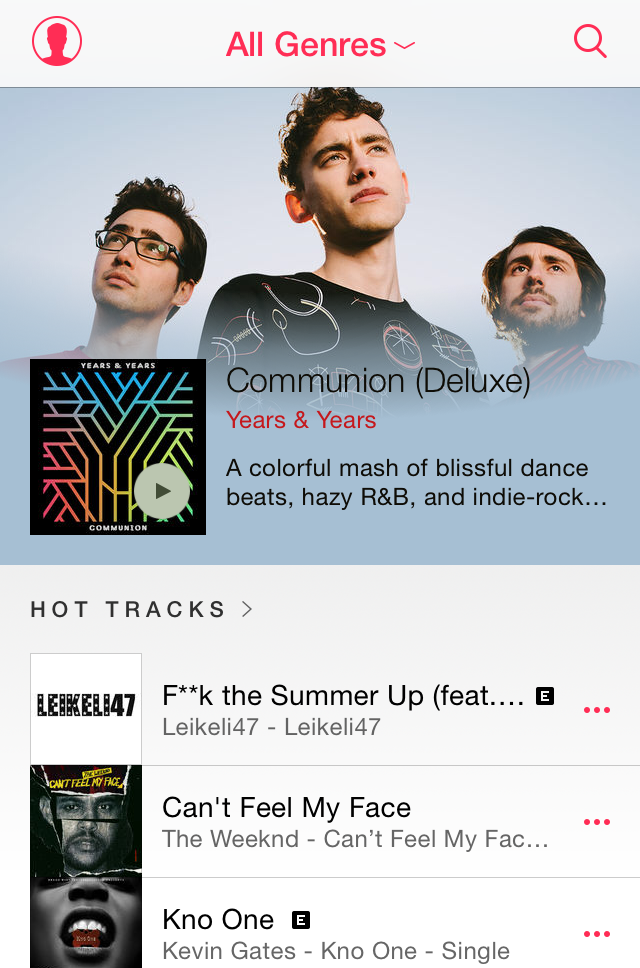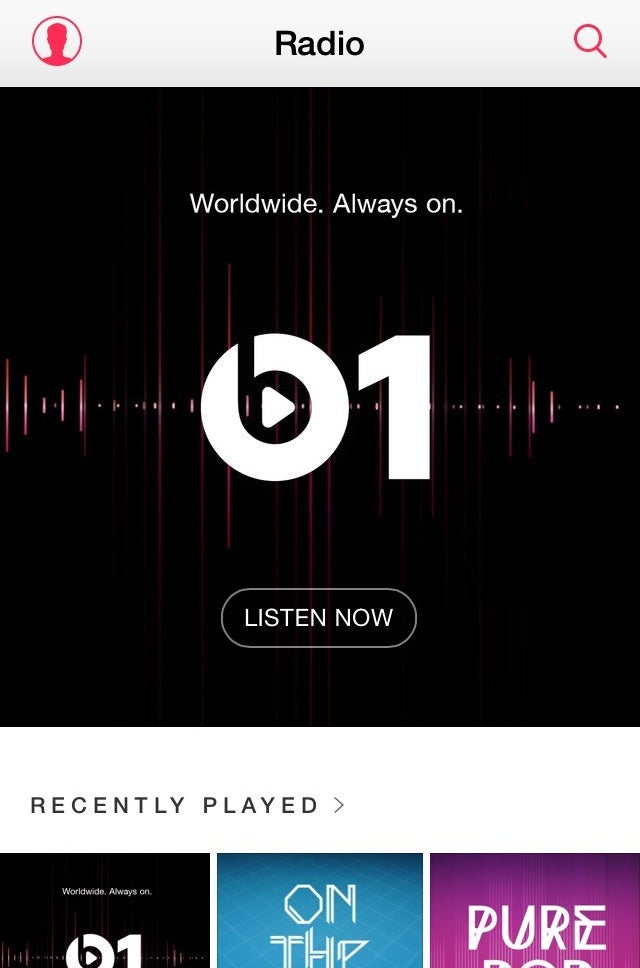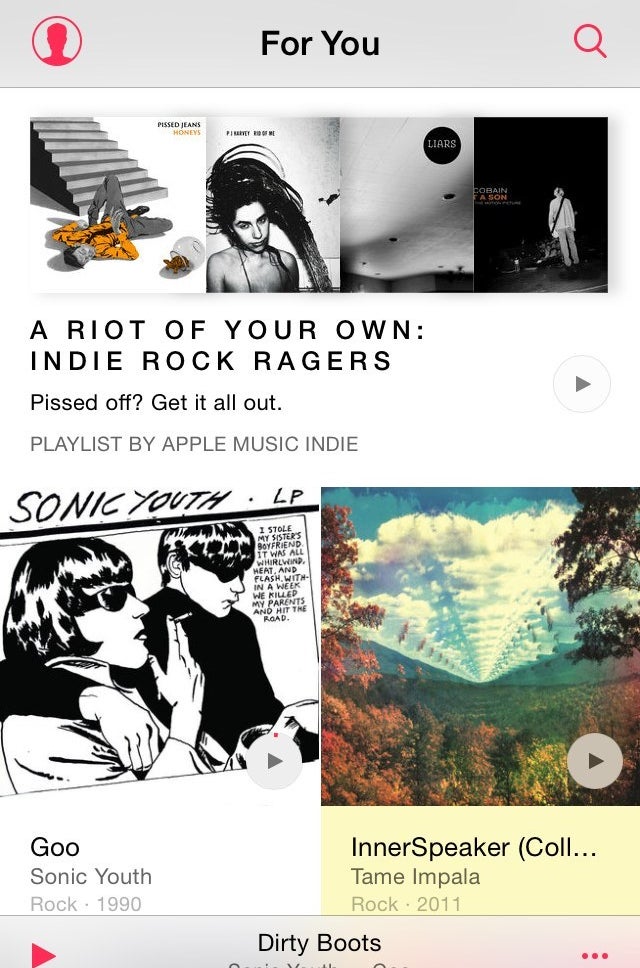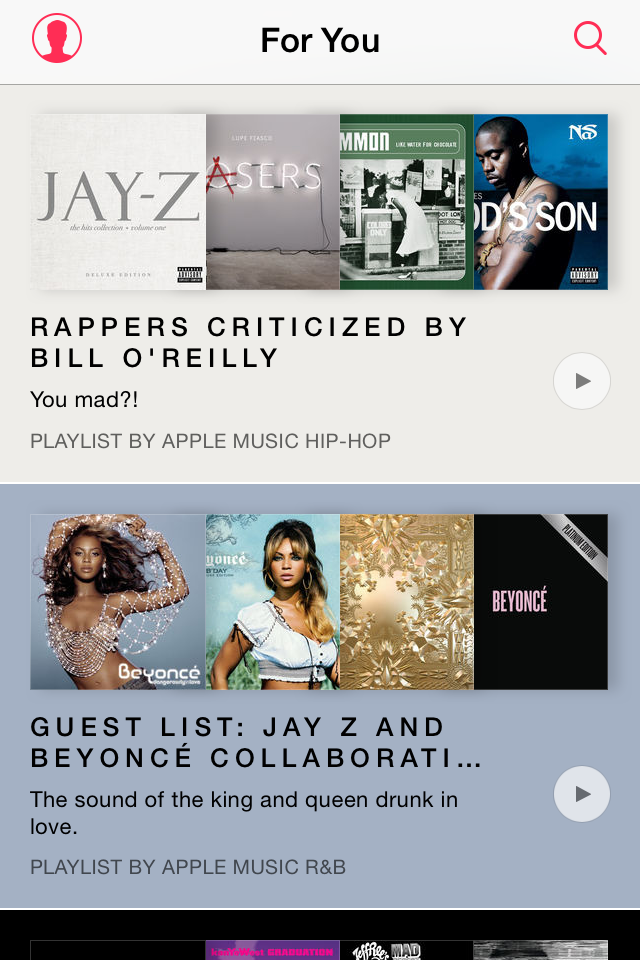


I’m a longtime Spotify premium subscriber, but while on a trip out of town over the 4th of July weekend, I used the new Apple Music streaming service as my sole source for tunes, as I have exclusively since the app was released last Tuesday. It’s got all of the songs, albums, and playlists from my iTunes library baked in automatically — one of the key advantages of Apple Music over competing services like Spotify and Google Play All Access — but, like a lot of heavy music consumers who have embraced accessing music as a more convenient alternative to owning it, these days my iTunes collection is depressingly stale and rarely used. The last time I downloaded an album that wasn’t purchased in a surprise-induced panic at 1:00 in the morning (looking at you Drake and Bey), Charlie Sheen was America’s favorite meme generator, and Oprah was still on TV every day.
In desperate need for new jams for my trip, to the sort of town that has one pub and questionable cell service, I swiped to Apple Music’s “New” section and grabbed albums by Miguel, The Internet, and Shamir, plus the new Demi Lovato single, clicking to make them available offline (Note: Making music available offline on Apple Music requires turning on Apple’s iCloud Music Library, a process some people have reported issues with. I was able to do it without any headaches, but be forewarned). Then I did a quick search for recent favorites — Kehlani, A$AP Rocky, Erik Hassle — and picked those up as well. All of the albums started downloading instantly to the app’s ”My Music” section, no purchase required, where they lived seamlessly next to my old stuff.
This is a simple but significant design detail. Flicking through “My Music,” I got a giddy blast from the past seeing albums that I once spent countless hours dutifully accumulating and cataloguing — a matter of pride and self-determination for teenagers in ancient times — reupholstered with a gleaming, elegant new interface. Uniting your new favorites with your old staples isn’t one of the big things Apple has focused on in the marketing push for Apple Music, but for a digitally divided music nerd like me, the experience was unexpectedly profound. There was the Bloc Party album that got me through finals, the Wild Nothing album I wore out when I first moved to New York, the Lil Wayne mixtape that soundtracked my first internship. Many other streaming services want to replicate or replace your music library, but Apple Music actually lets you resurrect it.
The main challenge for Apple Music, as I wrote when it was announced last month, is to reach the vast majority of music consumers who have never tried an on-demand streaming service — casual listeners and people over 30. So one of the things that surprised me while using the app over the past 10 days, was just how much it seems to be overtly courting the opposite crowd — high-volume music consumers with a stockpile of existing songs and an even bigger appetite for new ones. In other words, people like me.
If you want to know whom Cupertino had in mind when it made Apple Music, it’s instructive to look at Beats 1. The 24-hour, celebrity DJ-driven radio station redux that serves as the beating heart of the service is a hipster utopia led by an oligarchy of cool kids and tastemakers. High-rotation songs by buzzy, but little-known artists like Bully and Gallant, and a slate of shows from hosts including Zane Lowe, St. Vincent, Jaden Smith, and Ezra Koenig give the station a sensibility that’s more Pigeons & Planes than Billboard, which should give you pause coming from a company whose last experiment with music looked like this. What does $3 billion buy you? Street cred, apparently.
Beats 1’s genre-agnostic approach can be jarring if you’re used to listening to traditional radio or automated playlists based on a favorite song or specific tempo. Spend any significant amount of time listening to the station and you can expect to hear songs that you won’t like, or would never have chosen for yourself. (For me, that included the agro Muse headbanger “Reapers.”) But as a recommendation engine, and a broad-ranging survey of what contemporary music sounds like right this second, it excels. I listen to dozens of new songs every day for my job, but on Beats 1 I discovered great songs from artists I’d never heard of, including Londoners Rationale and Nao. My main criticism of the station is that I’d actually like more variety. Like older forms of broadcast radio, Beats 1 has a tedious habit of playing a handful of favored songs over and over again, until they've been drained of all texture and flavor and nothing but gristle and resentment remain.


Elsewhere on Apple Music, music nerds should find plenty to reward gluttonous behavior and wanton curiosity. I’m the type that prefers to make my own playlists, rather than have someone else make them for me, but in the “For You” section, which presents playlists and albums based on artists and genres you tell the service you like when signing up, even my interest was piqued by cheekily specific and wonky collections including “Rappers Criticized By Bill O’Reilly” and “Feminism In The ‘90s.” Highly curated playlists on streaming services are nothing new, of course, but I mostly ignore them on Spotify, where they’re safely tucked away behind a number of inscrutable menu options. Like a lot of things with Apple Music, and Apple more generally, streamlining and beautification go a long way here. The Apple Music interface does a better job of surfacing relevant playlists seamlessly, and ensuring that they’re never more than a single tap away.
One area where Apple has certainly not improved on its competitors is “Connect,” the Tumblr-meets-SoundCloud platform for artists that’s built into Apple Music. For most of the 10 days that I’ve used the service, Connect has been sterile and superfluous at best and embarrassingly half-baked at worst. It’s buggy, especially on the desktop version, and devoid of content that would be interesting to all but the most impressionable of superfans. Apple intended Connect to be a casual and stimulating meeting space for artists and fans, but right now it’s more like an awkwardly formal mixer: Attendance is low, and the mood is toxic.
The thing that I’ve missed the most about Spotify while using Apple Music is a sense of community. Unlike on Spotify, you can’t make your playlists publicly accessible on Apple Music, or follow the playlists that your friends make. Indeed, right now it’s all but impossible to connect with other people inside of Apple Music — while using the app, you’re alone in the walled garden that’s been created for you. Apple has never had a good track record of incorporating social elements into its software (one word: Ping), and, depressingly, Apple Music seems to be continuing that legacy. If I had one wish for the next version of the service, it’d be for a way to interact and share things with your friends and likeminded strangers. Listening alone can be wonderful, but music at its best brings people together.
While I’m making wishes, here’s one more: continuity. Apple Music doesn’t have any memory of what you do while browsing, which makes for an experience that can feel frustratingly ephemeral. If you closed out of a playlist you were enjoying without committing the name to memory or downloading it to your phone, good luck finding it again. Inexplicably, there are no bookmarks (a heart button on music pages appears to be nonfunctional). In a better version of the service, and as on other competing services, either your profile page or My Music would include music that you’ve favorited as well as recent plays.
Ten days in, my experience with Apple Music has been mostly positive, with a few disappointing annoyances. Until they're ironed out, I won't be canceling my Spotify subscription just yet. But more than any other streaming service currently available, Apple Music manages to flatten the last 15 years of platform evolution into a shiny and attractive new monolith. My Music offers a second chance at life for your old catalog, and Beats 1, For You, and New form a compelling troika for people who get excited about new music. At its best, the service is something like a digital riff on the music megastores of the ‘90s and early 2000s — Tower Records, Sam Goody, Virgin — places where music was exalted and desired and shared with urgency, and where you could get lost browsing for hours until everything old was new again.
